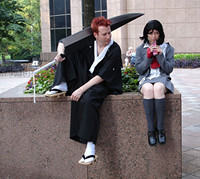 Overall Rating: A-
Overall Rating: A-Synopsis: xxxHolic by Clamp follows Watanuki, an orphan who is plagued by spirits. While being chased by spirits, Watanuki runs into a strange shop and meets a strange woman named Yūko. She turns out to be a powerful witch, and makes a deal with Watanuki to help him remove his "curse" in exchange for working in her shop and cooking for her. Hijinks and adventure ensue.
I can't remember now why I picked up the first volume of xxxHolic, but I'm glad I did. The series starts off innocently enough, with the main character, Watanuki, being chased by spirits. By chance, he touches the fence of a strange shop, and the spirits disappear. But wait! "There are no coincidences, only hitsuzen". Hitsuzen, or fate, is one of the recurring themes in xxxHolic, and Watanuki's "chance" encounter at the strange shop leads him to meeting the shop's owner, Yūko, and his life is changed.
She offers to help him lift his "curse" (being able to see and interact with spirits), but only if he can pay the price. Since he can't pay up front, he becomes her indentured servant, cleaning the shop and cooking for her. The series really picks up though after the introduction of Watanuki's "rival" Dômeki. I put rival in quotes because it's one sided. While Watanuki considers Dômeki his rival, Dômeki alternates between seemingly not caring about Watanuki and protecting him. Dômeki can't see spirits, but he can exorcise them, so even though Watanuki hates it when he's around, Watanuki often needs Dômeki's help.
xxxHolic combines Japanese folklore and mythology with humor to excellent effect. I definitely recommend checking it out.















